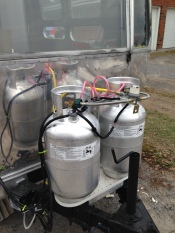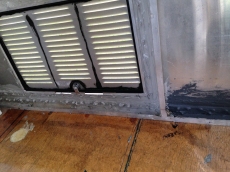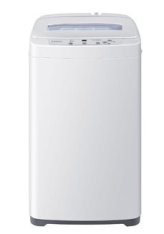Installation of propane lines should be done by a qualified professional, though the prices and services offered varies widely. I would recommend getting several quotes to compare as those I was given ranged from $1,200 without mobile service to $400 with.
Some RV places may be hesitant to work on vintage trailers so you could also try heating and cooling companies, some of them may be familiar with RV requirements.
For my setup, I used 2 x 30lbs aluminum propane tanks. This is the regulator that I went with. You will need 2 pigtail connectors.
Buy these items ahead of time and have your tanks filled in advance too, so that the installer can test your appliances. New propane tanks need to be purged before filling.
(The pink cord in the photos is just a bike lock to secure the propane tanks temporarily. The yellow is the main propane line and can be painted to match the trailer)
Propane appliances need to be adequately vented, check the manual of your appliances for required vent sizes and placement. In some cases you may be able to use existing vents, in my case I had to enlarge an existing one and install a new cover for the fridge vent. I covered the plywood subfloor with an epoxy resin in this area in order to ensure waterproofing.
From inside the trailer, you will need to build an enclosure to secure the fridge, as can be seen in the first photo below. Seal the edges with silicon. The specific fridge that I chose was the Atwood Helium 8 cubic ft fridge. It is large enough, has many great features such as lips on the edges of shelves to prevent items from sliding around in transit, locking doors, door alarms, a level to ensure the trailer is positioned evenly, separate freezer and with the touch of a button it can switch from propane operation to AC power. For daytime use I will run it through the inverter to take advantage of solar power and then at night switch over to propane.
The second photo below shows the yellow propane line behind the fridge. You can see the lower vent as well. Have your installer leave a bit of extra line in case you need to move your appliance out for any reason.
The next appliance is the hot water heater. It requires venting through the floor, both for exhaust and a separate vent for air intake. There are a few options for RV water heaters, 6 gallon, 10 gallon or on-demand.
Being in Canada where winter temperatures can be -30C, I had little choice but to go with the only all weather on-demand water heater on the market – The PrecissionTemp 550. The second and third photos show the cold water in, hot water out and at the very bottom is the propane inlet.
The range is the last propane appliance I required. After much research, I decided to go with the Danby 20in Space Saver. It gets great reviews and the only negative posts on Amazon have to do with its colour not matching the description on the page. This is true, the colour is darker than stainless steel but I quite like it anyway. It has a very nice look and fits perfectly in small spaces but also has all the features of a regular residential oven. This range comes from the factory set for natural gas but is easily converted to propane with the included conversion kit. The photo below is of the back of the oven where the propane line is installed.
In the rear of the Airstream, where the washroom is located, I also installed a washing machine. Haier makes several very small models for tight spaces, all of which run off AC power. Below is the 1.5 cu ft. model.
Below are a few photos of the propane lines running underneath the trailer.
















Wouldn’t it have been better to run the LP lines in the floor before the insulation? It just seems dangerous having them hanging there above the road.
Its not recommended to run propane lines inside any structure (In some places its actually illegal) Airstream recommended running them on the bottom exterior as that is how they also do theirs.